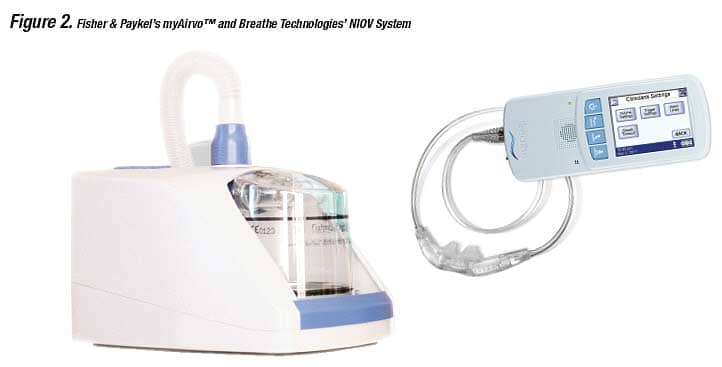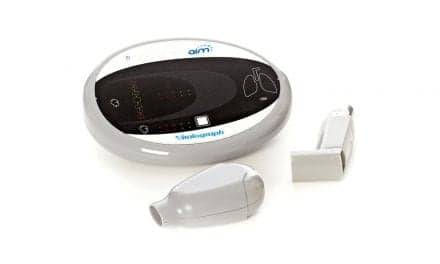
As a result of the recent high visibility campaigns to raise awareness of the condition, chronic obstructive pulmonary disease (COPD) is gaining recognition as an important disabling disease impacting many lives. The “Drive for COPD” campaign1 has been successful in bringing COPD from a feared and misunderstood disease to a more recognized problem that needs early identification and treatment to control complications, comorbidities, and cost.
An estimated 12 million-plus patients in the United States have been diagnosed with COPD, and as many as another 12 million have yet to be diagnosed. Approximately 2 million patients with both acute and chronic lung conditions require supplemental oxygen in their home to maintain adequate oxygenation, but how many of these patients have a ventilatory component to their disease that is not being treated with pharmacological agents or oxygen is unknown. New technology is providing options that are showing promise as adjuncts to the mechanics of ventilation with oxygen as the driving mechanism.
WHAT ARE THE OPTIONS?
Low-flow (LF) oxygen therapy is provided to patients to compensate both for lung conditions that limit diffusion and/or perfusion, or for inadequate ambient pressure (high altitude), all of which prevent the patient from maintaining adequate oxygenation. LF oxygen therapy does not move gases into the lung; LF therapy only makes the gas available to be delivered to the lung. Ventilation is necessary to move oxygen into the respiratory system and remove carbon dioxide. Ventilation and perfusion are in a delicate balance that needs to be maintained to achieve balanced gas exchange.
High-flow (HF) oxygen therapy has become a popular option to provide the benefits of increased FiO2 and humidity and to augment ventilation. High-flow oxygen therapy has been an option for clinicians to provide a patient with higher FiO2 for decades, but it required mask therapy, which is cumbersome and tolerated by the patient for only a short time. The introduction of effective humidification systems that provide adequate hydration to inspired gases has allowed nasal HF therapy to be delivered to patients with the comfort and convenience necessary to gain acceptance and compliance with the therapy. High-flow therapy has been found to provide not only higher FiO2, but also effective humidification that helps to clear secretions; high flows of gas can flush dead space gas from the upper airway, assisting in carbon dioxide elimination.2Noninvasive open ventilation (NIOV) provides pressurized oxygen via a custom nasal interface that augments ventilation and addresses both oxygenation and ventilation issues. This system adds to the patient’s ventilation with a volume of oxygen provided by the ventilator as well as entraining air to provide a fixed FiO2. The NIOV system is designed to be portable (weighing 1 pound) to allow a patient to benefit from the augmented ventilation while doing activities of daily living. This new device is targeted for use by ambulatory patients who have sufficient ventilation to work with the NIOV system.3There are other methods of augmenting ventilation that have their own unique features and capabilities; yet HF oxygen and NIOV are gaining the most visibility. Bi-level ventilation with oxygen and transtracheal augmented ventilation (TTAV) have been described in the literature and are options for use when indicated, understood, and practical. This article will focus on HF oxygen and NIOV for home applications.

IMPAIRED VENTILATION
Oxygen is a wonderful drug that, when prescribed properly, applied therapeutically, and used appropriately, can reduce dyspnea, reduce work of breathing, and improve a patient’s physical and mental function,4 but oxygen will only be as beneficial as the effectiveness of an individual’s ventilation. Airway patency is typically treated with pharmacological agents to reduce the constriction often associated with chronic lung disease. Once the airway is open, however, there is still a need for mechanical movement of air into and out of the lung. If lung function has deteriorated to a point where the mechanics of ventilation are impaired, drug therapy will not overcome that limitation.
Once a patient’s lung function has decreased to a point where ventilation is impacting oxygenation, the patient will begin to slow down, decondition, and have exacerbations. This was historically thought to be the end of the options for treating a patient, and comfort care was initiated; now, new technology has created options to evaluate. Many patients feel that quantity of life is not considered a good alternative to quality of life, and some home patients have discovered that when they need ventilation, they can use the bi-level device provided for their sleep therapy to help them “catch their breath” during the day. These patients have taken the initiative to use their home devices to their benefit even without the direction or support of their physician. This trend is being seen more often in many aspects of home respiratory care. There is evidence in the literature that noninvasive home ventilation helps reduce the patient’s work of breathing and increases their ability to exercise. The articles describe the benefits of augmented ventilation for a patient’s ability to increase physical activity, with the suggestion that resting a patient’s ventilator muscles provides the basis for improved lung function and activity.5

HIGH-FLOW OXYGENATION
High-flow oxygen in the hospital has been shown to benefit patients with secretion issues and provides for flushing of dead space, assisting in carbon dioxide elimination.6 High-flow oxygen has been used to allow patients to take a break from noninvasive ventilation to eat, talk, and relieve the pressure from full face masks. The benefits of HF oxygen continue to be explored, and more evidence of the applications and possible outcomes with this technology continues to accumulate.
Home application of HF oxygen has logistical considerations due to the cost of home oxygen, but HF can be accomplished in the home with blowers providing room air that can assist with humidification therapy and flushing of dead space. High flow from either oxygen or air requires a gas or power source to provide the therapy, making an ambulatory option less feasible at this time.
NONINVASIVE OPEN VENTILATION
NIOV using pressurized oxygen has increased the potential to provide augmented ventilation to an ambulatory patient. The control mechanism for NIOV weighs 1 pound and can deliver a pressurized volume of gas from the controller and increase the amount of ventilation by incorporating a venturi mechanism into the nasal interface. This device triggers on inspiration and delivers a prescribed volume of gas with each breath. The oxygen delivery is fixed at 40% FiO2 by combining the source oxygen (100%) with the entrained room air. The percent of inspiratory time from the device is adjustable as is the triggering sensitivity, so ventilation can be set for patient comfort by the clinician. Providing a supplemental volume of gas with the patient’s own ventilation augments their ventilation to reduce dyspnea and work of breathing, and increase overall comfort, while the patient is ambulatory. Initial investigations have shown that the device allows the patient to improve work performance while engaging in activities of daily living with less fatigue and greater comfort.
WHY IS AUGMENTED VENTILATION IMPORTANT?
Patients with chronic respiratory impairment have a progressive decline in their ventilation and perfusion capabilities. Early in their disease process, airway patency issues are identified and treated with pharmacological agents to keep airways open. As lung function continues to deteriorate and oxygenation is affected, long-term oxygen therapy is provided to maintain adequate oxygenation. The continual escalation of the patient’s airway patency limitations, loss of lung structure, secretion accumulation, and physical deconditioning combine to eventually bring the patient to the end of their journey.
Ventilation impairment often is associated with hospitalization to address respiratory failure and to help patients overcome an exacerbation. The current trend in health care is to create a disincentive for patients to return to the hospital for routine care of their chronic condition by encouraging proper discharge planning and effective home respiratory care. Traditional therapies focus on the process of prescribing medications and oxygen for chronic lung diseases, yet do not embrace new options to address hospital recidivism. Little attention is paid to a patient’s ventilatory issues in the home, so for a patient who suffers from consistent respiratory insufficiency or failure, there are few options to consider. High-flow humidified air or oxygen has the potential to augment flushing of dead space in the upper airway. Even a slight assistance with reducing carbon dioxide levels can help a patient overcome a mild respiratory insufficiency episode. As previously mentioned, high flow is a stationary device at this time so the therapy can be provided only when the patient is not moving.
Maintaining activity is a key component to overall health for both a healthy person and one with chronic lung disease. It has been shown that COPD patients who exercise have overall better health with fewer hospitalizations and improved mortality. The NOTT study revisited4 documented that patients with a high walking level on continuous oxygen therapy had approximately 80% survival at the end of the study compared to patients with a low walking level on nocturnal oxygen therapy, who had a survival rate of approximately 30%. The key to patient benefits on long-term oxygen therapy has been the introduction of ambulatory oxygen systems that encourage a patient to exercise with oxygen. Effective portable oxygen therapy has allowed patients to exercise, condition, and live a more normal life than was possible when stationary oxygen was the only option. Again, LF oxygen only provides the availability of the gas; the patient must still be ventilating effectively to benefit.
Ambulatory ventilation for home patients can provide an option for patients who have limited ability to effectively move gas in and out of their lungs. Physical activity increases work of breathing with the depletion of oxygen available for metabolism as well as the production of carbon dioxide. Chronic lung patients quickly become fatigued and short of breath with even limited activity. Portable augmented ventilation can provide an option to address a patient’s ventilation limitation with activity and allow for the initiation or continuation of a pulmonary rehabilitation program. Patients who find they do not have the ability to exercise with their long-term oxygen therapy (LTOT) system may discover that, with the assistance of a ventilation device, exercise may become available to them again.
CONCLUSION
Home respiratory care is evolving with new products and programs that are the result of turbulent times with health care reform. Traditional home respiratory care has focused on drugs and devices that require a patient to have adequate ventilation to deliver the medications and gases to the lung. These inhalation techniques only address the inspiratory side of respiration with little attention to or options for exhalation. To completely address patients’ needs for respiration, both inspiratory care and expiratory care need to be available. Augmented ventilation in the home is an important new tool for clinicians to treat the ventilation limitations of patients with chronic lung conditions impacting effective gas exchange.
Robert McCoy, BS, RRT, FAARC, is owner and managing director, Valley Inspired Products Inc, Apple Valley, Minn. For further information, contact [email protected].
REFERENCES
- Drive4COPD. Available at: www.drive4copd.org. Accessed July 13, 2012.
- Parke RL, McGuinness SP, Eccleston M. Delivering humidified high-flow therapy at increasing gas-flow rates generates higher airway pressure. Presented at: the European Society of Intensive Care Medicine (ESICM) Scientific Meeting; September 21-24, 2008; Lisbon.
- Garvey C, Hilling L, Cayou C, et al. Open, noninvasive ventilation using a 1-lb ventilator, oxygen, and a low profile mask improves 6MWT distances in advanced COPD. Presented at: the American Thoracic Society International Conference; May 14-19, 2011; Denver, Colo.
- Petty TL, Bliss PL. Ambulatory oxygen therapy, exercise and survival with advanced chronic obstructive pulmonary disease (the Nocturnal Oxygen Therapy Trial revisited). Respir Care. 2000;45:204-11.
- Carlin BW. Pulmonary rehabilitation and chronic lung disease: opportunities for the respiratory therapist. Respir Care. 2009;54:1091-9.
- Groves N, Tobin A. High-flow nasal oxygen generates positive airway pressure in adult volunteers. Aust Crit Care. 2007;20:126-31.









